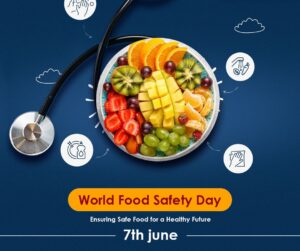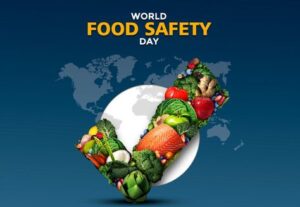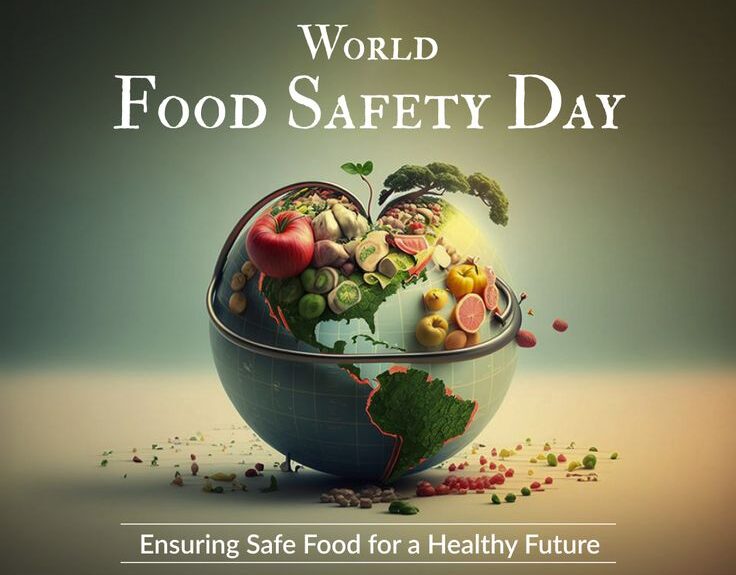🍽️ World Food Safety Day: History, Facts, Timeline, FAQs, Significance, Wishing, and Societal Impact
Food is more than nourishment—it is a basic human right, a source of culture, comfort, and community. But what if the food we eat is silently harming us?
- 📜 History of World Food Safety Day
- 📅 Timeline of World Food Safety Day
- 🧠 7 Powerful Facts About Food Safety You Need to Know
- 🌱 Why World Food Safety Day Matters – The Significance
- 🌍 Global Observance and Activities
- 🤔 FAQs: World Food Safety Day Explained
- Q1: What is the theme for World Food Safety Day 2025?
- Q2: Who organizes this day?
- Q3: Why is food safety important in developing countries?
- Q4: How can I participate?
- Q5: Is food safety linked to climate change?
- ✨ Wishing Messages for World Food Safety Day
- 🔑 Key Observance Points
- 🧬 Food Safety’s Impact on Our Daily Life
- 🫂 Importance in Society
- 🧾 Conclusion – Safe Food, Stronger World
Every year, unsafe food causes over 600 million cases of foodborne illnesses globally, leading to 420,000 deaths, many of them children under 5 years old.
This is why World Food Safety Day, celebrated on June 7, is so critical. It draws attention to a global issue that touches every kitchen, every plate, and every life.
Let’s explore this essential day from every angle—its past, present, and the urgent reasons it must shape our future.
📜 History of World Food Safety Day
The idea was rooted in a joint effort by the Food and Agriculture Organization (FAO) and the World Health Organization (WHO).
In 2018, the United Nations General Assembly proclaimed June 7 as World Food Safety Day, recognizing the importance of food safety for public health, economic prosperity, and food security.
The first official celebration took place in 2019, and each year has had a unique theme and action-oriented approach.
The intention? To inspire action that helps prevent, detect, and manage foodborne risks—because everyone has a role to play, from farm to fork.

📅 Timeline of World Food Safety Day
| Year | Event |
|---|---|
| 2018 | UN General Assembly declares June 7 as World Food Safety Day |
| 2019 | First observance under theme: “Food Safety, Everyone’s Business” |
| 2020 | Focus on pandemic-era food safety |
| 2021 | Emphasis on collective action: “Safe food now for a healthy tomorrow” |
| 2023 | Theme: “Food standards save lives” |
| 2025 | Expected focus: “Digital Innovation and Safe Food Systems” |
🧠 7 Powerful Facts About Food Safety You Need to Know
1 in 10 people fall ill every year due to contaminated food.
Foodborne diseases are preventable through simple hygiene and safety measures.
Unsafe food affects children the most—125,000 children die yearly due to foodborne illness.
Contaminants include bacteria, viruses, parasites, and chemical substances like pesticides.
Proper food storage, cooking, and handling can prevent over 90% of foodborne illnesses.
Globalization means food travels farther—increasing chances of contamination along the supply chain.
The economic cost of unsafe food is estimated at $110 billion annually in lost productivity and medical expenses.
🌱 Why World Food Safety Day Matters – The Significance
✅ Public Health
Foodborne illnesses lead to hospitalizations, long-term health issues like kidney failure, and even death. This day helps raise awareness and reduce risks.
✅ Economic Stability
Contaminated food can destroy industries, ruin reputations, and create massive recalls. It impacts farmers, traders, businesses, and governments alike.
✅ Food Security
Without safe food, nutrition cannot be guaranteed. Unsafe food leads to malnutrition and weakens immune systems—especially in children and the elderly.
✅ Global Trade
Exporting and importing countries depend on global food standards. A single contaminated product can cause nationwide bans and global mistrust.
✅ Individual Empowerment
This day empowers individuals to:
Wash hands before cooking
Store food at proper temperatures
Cook meats thoroughly
Avoid cross-contamination

🌍 Global Observance and Activities
Seminars & Webinars hosted by WHO, FAO, and universities
Training programs for food handlers, chefs, and farmers
Health campaigns in schools, hospitals, and community centers
Infographics and posters shared on social media using hashtags like #WorldFoodSafetyDay and #SafeFood
Street plays and community events in villages and urban markets
🤔 FAQs: World Food Safety Day Explained
Q1: What is the theme for World Food Safety Day 2025?
Expected: “Digital Innovation and Safe Food Systems”, focusing on AI, traceability, and tech in food safety.
Q2: Who organizes this day?
Primarily FAO and WHO, with support from UN member states, NGOs, academic institutions, and civil society.
Q3: Why is food safety important in developing countries?
Because food storage, transportation, and hygiene infrastructure may be lacking, making food contamination more likely.
Q4: How can I participate?
Start at home! Use separate cutting boards, check expiry dates, keep cooked and raw foods apart, and educate others.
Q5: Is food safety linked to climate change?
Yes! Rising temperatures can increase bacterial growth, affect water quality, and disturb supply chains.
✨ Wishing Messages for World Food Safety Day
🥗 “Here’s to a plate full of health, not hazards. Happy World Food Safety Day!”
🍱 “May every meal be a safe one. Let’s keep food safety on our menu.”
🥘 “Wishing you fresh, healthy, and safe bites—today and always.”
🧼 “Safe food is a shared responsibility. Celebrate it, promote it, live it.”
🔑 Key Observance Points
Wash hands and cooking tools
Check food temperature before serving
Don’t consume expired or smelly food
Avoid cross-contamination from raw meat
Store leftovers properly
Teach food safety to children
Support local vendors who maintain hygiene
🧬 Food Safety’s Impact on Our Daily Life
Food safety may seem like a backstage issue, but it plays a central role in your health, happiness, and future.
| Aspect | How It Affects You |
|---|---|
| Health | Prevents diarrhea, food poisoning, and chronic illnesses |
| Nutrition | Safe food preserves nutrients |
| Economy | Lower medical bills and higher productivity |
| Environment | Reduces food waste |
| Trust | Builds confidence in restaurants and food brands |
Unsafe food can ruin a family meal, a business, or even an entire supply chain.
🫂 Importance in Society
Protecting Vulnerable Groups
Children, the elderly, and pregnant women are most at risk from contaminated food.Strengthening Healthcare
Fewer cases of foodborne illnesses reduce pressure on hospitals and doctors.Boosting National Reputation
Countries with high food safety standards have stronger trade relationships.Educating Future Generations
From school lunches to street snacks, children must learn what safe eating means.Promoting Innovation
This day pushes food industries to embrace technology like AI traceability, cold chain monitoring, and clean-label transparency.
🧾 Conclusion – Safe Food, Stronger World
Food is sacred—it nourishes not only our bodies but our communities, our economies, and our planet.
World Food Safety Day is not just for food inspectors or chefs—it’s for every parent, student, shopkeeper, vendor, farmer, and policymaker. Whether you’re preparing a lunchbox, running a restaurant, or buying fruit at the market—you are part of the food safety chain.
Let’s make food safety a part of our everyday behavior—not just on June 7, but year-round. Because every meal should be safe, every bite clean, and every life protected.








